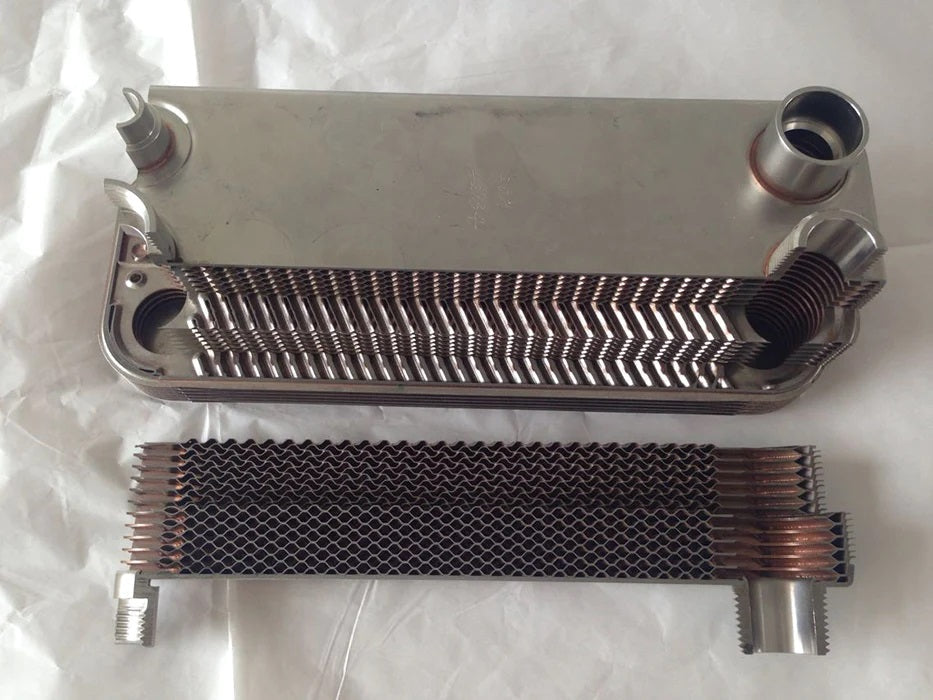With many heating options available on the market, finding the right solution tailored to your unique requirements can be daunting. At Alfa Heating, we're here to guide you through the intricacies of how to size a plate heat exchanger and more. Our guide below elaborates on understanding the right plate heat exchanger size and how it can benefit your space.
What is a Plate Heat Exchanger?
As you embark on the journey to discern how to size a plate heat exchanger, it's crucial first to grasp its foundational concepts. At their core, plate heat exchangers are sophisticated devices crafted to enable the seamless transfer of heat between two separate fluids while preventing any mixture of the two. This unique feature has made them an indispensable tool in numerous industries, ranging from food processing to HVAC systems, and even in the world of renewable energy. Their design, which combines efficiency with a space-saving structure, is particularly noteworthy. At Alfa Heating, our commitment to offering a comprehensive range of Plate Heat Exchangers ensures that every customer can pinpoint the exact size and type suited to their specifications. So, if you're pondering the question, “What size plate heat exchanger do I need?” read on to dive deeper into this topic.
Discover our most popular product categories – find what you need today!- Air to Water Heat Exchangers
- Water to Air Heat Exchangers
- Plate Heat Exchangers
- Oil Coolers & Intercoolers
- Tankless Water Heaters
Factors Determining Plate Heat Exchanger Size
When you find yourself contemplating the size of a plate heat exchanger, remember that several elements come into play. The overarching question – “What size plate heat exchanger do I need?” — might seem straightforward, but the answer is multifaceted. Here's a closer look:
1. Flow Rate: Flow rate measures how much fluid will traverse through the exchanger within a set timeframe. A higher flow rate could necessitate a larger exchanger or more plates, thereby influencing the plate heat exchanger size. This is a fundamental parameter when considering how to size a plate heat exchanger.
2. Temperature Requirement: The efficiency of an exchanger is also gauged by its ability to achieve the desired temperature outputs. If the incoming fluid is significantly colder or hotter than the desired output, you might need a larger exchanger to compensate. Recognizing the temperature gradient – the difference between the entry and exit temperatures – is vital in determining the appropriate plate heat exchanger size.
3. Type of Fluids: Understanding the fluids in question is at the heart of the sizing plate heat exchangers process. Every fluid, be it water, oil, or a glycol mixture, possesses unique properties. Their specific heat capacities and viscosities can vastly impact how effectively heat is transferred. For instance, a fluid with high viscosity might require a larger heat exchanger to function effectively.
By taking the time to assess these factors in-depth, you are well on your way to making an informed decision about the right plate heat exchanger size for your needs. Remember, it's not just about meeting immediate needs but also ensuring that the chosen solution is sustainable and efficient in the long run.
Benefits of Choosing the Right Size
The question, “What size plate heat exchanger do I need?” is not just about meeting the basic requirements but also about reaping multiple benefits that come with the right choice:
- Optimum Performance: A heat exchanger that is sized correctly ensures that it works at its peak efficiency. It guarantees that there are no unexpected temperature fluctuations and delivers consistent performance. It does so without drawing excessive energy, ensuring that your operational costs remain in check.
- Durability and Longevity: The lifespan of a plate heat exchanger is intricately tied to how to size a plate heat exchanger appropriately. When an exchanger is neither too large nor too small for its intended purpose, it runs without undue stress. This minimizes wear and tear and ensures that the equipment remains in top-notch condition for longer.
- Cost Efficiency and Savings: Correct plate heat exchanger size becomes a long-term investment beyond the immediate benefits. Over its operational life, a properly sized exchanger can save significant amounts in energy costs, repair, and maintenance.
Consultation and Expert Guidance on Sizing
Embarking on the journey to determine how to size a plate heat exchanger can be a bit challenging without the right guidance. Alfa Heating stands ready with a team of experts to assist you. Our professionals will understand your needs, evaluate your requirements, and guide you toward the best-suited solution. This ensures not only an informed decision but also a wise investment.
Concluding Thoughts
The emphasis on understanding plate heat exchanger size cannot be overstated. A right-sized exchanger means optimal performance, long service life, and cost efficiency. It's a holistic approach, ensuring you don't just pick a product but the right product tailored to your requirements. With Alfa Heating’s expertise, your journey toward making that perfect choice becomes effortless and informed.
See our last posts

